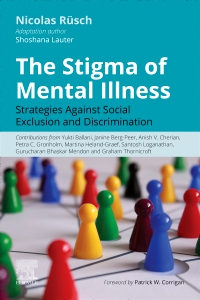
The Stigma of Mental Illness - E-Book, 1st Edition
Hardcover

$30.99
-
1. Introduction 1.1. Aims and content of the book (i) To clarify forms and consequences of stigma and (ii) to outline anti-stigma programs, including evidence on their efficacy
1.2. Language Person-first language, thought police as distraction from anti-stigma work
1.3. Types of anti-stigma agendas Services agenda, rights agenda, self-worth agenda
1.4. Should we sugarcoat stigma by downplaying the challenges of mental illness? Impairments due to mental illness, disability and label
1.5. Studies and evidence Types of available evidence, research synthesis, pros and cons of meta-analyses; this will inform readers about types of evidence that are referred to throughout this book
1.6. Diagnosis and mental health continuum Pros and cons of psychiatric diagnoses, their limited validity, continuum model
1.7. Stigma in a time of rapid societal change Increased difficulty for disadvantaged individuals with mental illness in a world in crisis (Social inequality, migration etc.)
1.8. What is not covered in this book Special topics and populations, e.g. people in forensic psychiatry; mental illness stigma in low and middle-income countries
1.9. Perspective of this book Written by the author in his roles as researcher, clinician, peer and anti-stigma worker; voices of service users and relatives are present throughout the book with quotes from qualitative research as well as by the contributions of JBP and MHG (see above)
2. Historical and social aspects of mental illness and social exclusion The aim of this chapter is to contextualize mental illness stigma in terms of its historical and social aspects – both of which are crucial to understand current stigma and ways to address it. 2.1. Historical aspects Madness in ancient Greece, Greek tragedy and concept of melancholia; forced sterilization and "euthanasia" in Nazi Germany; psychiatric reform movement and anti-psychiatry of the 1960ies
2.2. Prevalence and burden of mental disorders Prevalence, burden, disability-adjusted life years, costs of mental disorder in- and outside the mental healthcare system, lack of adequate policy response, key populations (e.g. youth), health economy perspective, "mental health in all policies" approach
2.3. Mental health as a task for society Social determinants of mental health, "deaths of despair", need for a social model of mental health, social solutions
3. What is stigma? This chapter introduces basic concepts of stigma as it applies to people with mental illness and also to other stigmatized conditions; the aim is to clarify the concepts and their implications for interventions based on sociological and social psychological literature (prior to discussing stigma as it specifically applies to people with mental illness in Chapters 5 ff.). 3.1. Terminology, models and forms of stigma 3.1.1. Origin of the word stigma 3.1.2. Stigma as umbrella term 3.1.3. Social cognitive model Stereotypes, prejudice, discrimination (Corrigan) 3.1.4. Sociological model Difference, labeling, separation, status loss, discrimination, power (Link & Phelan) 3.1.5. Forms of stigma: Public, self, structural 3.1.6. Levels of stigma Matter of degree (subtle/blatant), explicit vs. implicit, open vs. indirect, microaggression 3.1.7. Stigma and knowledge – mental health literacy 3.1.8. Intersectionality Double stigma, origin of concept
3.2. Categorization and stereotypes as basic elements of stigma 3.2.1. What is categorization? 3.2.2. Categorization and prejudice reduction De-categorization, group differentiation, re-categorization 3.2.3. What are stereotypes? 3.2.4. Stereotype content Fiske’s stereotype content model: warmth and competence; stereotypes and kernel of truth discussion; stereotypes as normal perception of bizarre behavior? 3.2.5. Development of stereotypes Unconscious association, outgroup homogeneity effect, illusory correlation 3.2.6. Maintenance of stereotypes Biased processing, linguistic intergroup bias etc. 3.2.7. Application of stereotypes 3.2.8. Changing stereotypes
3.3. Functions of stigma 3.3.1. Functions for individuals Downward comparisons, self-esteem, terror management 3.3.2. Functions for own group Social cooperation, dilemma of trust, social identity 3.3.3. Comprehensive models Social dominance, just world beliefs, system justification, "to keep people down, in or away" (Jo Phelan) 3.3.4. Evolutionary perspective Avoidance of illness risk, smoke detector principle and false positives/overreactions; avoidance of poor cooperation partners
4. Consequences of stigma 4.1. Consequences for the non-stigmatized Common stereotypes, ambivalence, anxiety/insecurity, discrepancy between self-reported attitudes and behavior
4.2. Consequences for the stigmatized Experiences of discrimination, stigma consciousness, stereotype threat, stigma stress, attributional ambiguity, stigma and poor health
4.3. How can stigmatized individuals cope with stigma? Blame discrimination, ingroup comparisons, secrecy, social withdrawal, challenge stigma
4.4. Interaction between the stigmatized and the non-stigmatized From the perspective of the non-stigmatized, and of the non-stigmatized
5. People with mental illness and their relatives 5.1. People with mental illness 5.1.1. Public stigma Public attitudes, change over time, experience and anticipation of discrimination, public stigma and self-stigma 5.1.2. Role of biological models of mental illness Attribution theory, genetic essentialism, consequences of biological models 5.1.3. Self-stigma, shame, why try What is self-stigma, predictors of self-stigma, empowerment and stigma resistance, awareness of illness/insight 5.1.4. Secrecy and disclosure Pros and cons of disclosure, conditions of disclosure 5.1.5. Stigma stress 5.1.6. Recovery and stigma 5.1.7. Stigma as a barrier to service use 5.1.8. Structural discrimination Legal aspects, funding for health services and research; other aspects of structural discrimination are discussed in the respective societal domains in Chapter 7
5.2. People with a history of suicidality Suicide stigma, stigma and suicide prevention
5.3. Young people with psychosis risk or first episode of psychosis
5.4. People with specific diagnoses Aim of this subchapter is to cover a number of diagnoses for which the content of stigma and its consequences differ from other mental disor

 as described in our
as described in our 